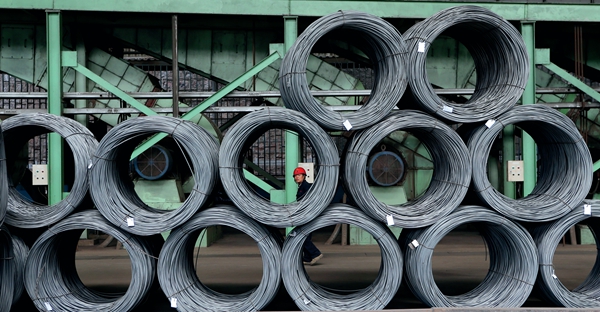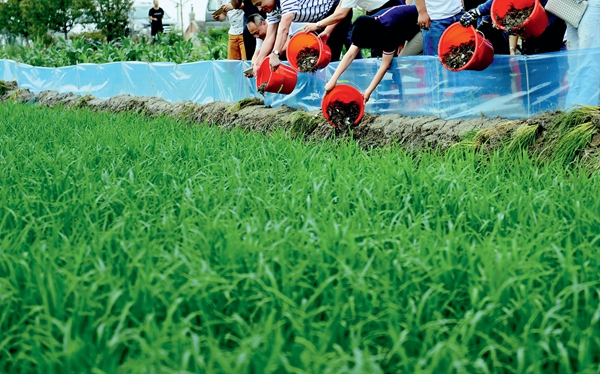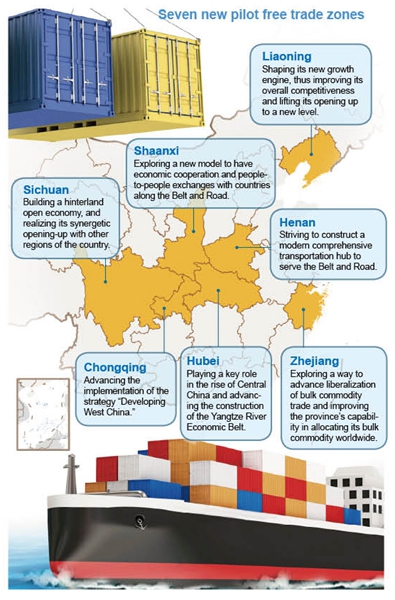By staff reporter ZHANG HUI
In the past, people’s reflexive response to realizing economic growth is to expand domestic demand, thus stimulating growth. Now, we need to change our mind and find new and modern means to achieve this: supply-side structural reform. By improving the supply system, we can emancipate productive forces and improve competitiveness, thus spurring economic development.
The reform aims to reduce invalid supply, expand useful supply, and improve the supply structure’s adaptability to the demand structure. Its major task is to cut overcapacity, reduce excess inventory, deleverage, lower costs, and strengthen areas of weakness.
 This is the Yukun Iron and Steel Co., Ltd. plant in Yuxi City, Yunnan Province. Yunnan is cutting overcapacity and upgrading its iron and steel companies.
This is the Yukun Iron and Steel Co., Ltd. plant in Yuxi City, Yunnan Province. Yunnan is cutting overcapacity and upgrading its iron and steel companies.

Chinese President Xi Jinping emphasized the importance of “supply-side structural reform” on November 10, 2015 at the 11th meeting of the CPC Central Leading Group for Financial and Economic Affairs. The goal is to improve the quality and efficiency of China’s supply system, nurture driving force for sustainable economic growth, thus achieving the overall improvement of China’s social productivity.
Primary Achievements
The major task of the supply-side structural reform is to cut overcapacity, reduce excess inventory, deleverage, lower costs, and strengthen areas of weakness, thereby realizing a supply-demand balance at a higher level.
Overcapacity has troubled China for a while, with a surplus of some industrial products far beyond the actual demand, which has caused falling prices of these products, therefore narrowing relevant companies’ profit margin. Meanwhile, many second- and third-tier cities in China have seen the rising inventory of commercial housing units. Cutting overcapacity will facilitate the flow of production factors and make prices of industrial products more rational. Destocking will help stabilize the real estate market and avoid big economic fluctuations, and lower the debt default risk by mobilizing capital flow.
 On June 25, 2017, in a neighborhood of Shenyang, Liaoning Province, people carefully put crabs into a paddy field. The model of raising crabs in a paddy field has not only bred non-polluted crabs, but also improved the paddy field’s overall output.
On June 25, 2017, in a neighborhood of Shenyang, Liaoning Province, people carefully put crabs into a paddy field. The model of raising crabs in a paddy field has not only bred non-polluted crabs, but also improved the paddy field’s overall output.
Dean of the China Institute for Studies in Energy Policy of Xiamen University, Lin Boqiang, pointed out that the priority of cutting overcapacity should be put on the high energy-consuming industries and sectors related to mineral resources and infrastructure construction. Since the reform policy was introduced, market mechanisms, economic measures, and legal means have been adopted across the country in light of specific conditions of different regions to shear overcapacity and phase out outdated capacity. Earlier this year, Premier Li Keqiang in his signed article published in Bloomberg Businessweek noted that China squeezed out 65 million tons of outdated steel capacity and more than 290 million tons of coal capacity in 2016. Owing to the joint efforts of government and related enterprises, 700,000 laid-off employees in the related industries found new jobs in 2016 after receiving training. All of these factors have promoted the healthy development of the related industries and made way for advanced capacity. Secretary of the CPC Hubei Provincial Committee Jiang Chaoliang said at a thematic briefing on the supply-side structural reform sponsored by the International Department of the CPC Central Committee on May 25, “Overcapacity has once put Wuhan Iron and Steel (Group) Company in an operation plight. Since last year, the company has made efforts to cut overcapacity, optimize product mix, improve the quality of products, and finally realize the strategic merger and reorganization with Shanghai-based Baosteel Group, setting a successful example for state-owned companies to carry out supply-side structural reform.”
Meanwhile, the country has also proactively reduced commercial housing inventory by advancing urbanization and rebuilding rundown areas, and revitalizing the leasing market. Minister of Housing and Urban-Rural Development Chen Zhenggao said at a press conference in late February that surveys showed migrant workers and farmers made up 50 percent of the home buyers in 2016. Some places have introduced a loan guarantee mechanism to help farmers and migrant workers to get loans. Chen indicated that primary achievement has been shown amid the destocking efforts. The total area of commercial building put up for sale across the country at the end of 2015 stood at 718 million sq. m., and had dropped to 646 million sq. m. by the end of June.

For quite a long time, Chinese enterprises have been laden with relatively heavy debt, in particularly those in heavy and chemical industries as well as the real estate sector. In October 2016, the State Council introduced a policy to lower companies’ leverage ratio, which maps out seven approaches to crack the conundrum. Among them, legal methods for a debt-for-equity swap have proved to be one of the most effective ways to help companies in need and blazed a way for transformation of financial institutions. Data from the National Bureau of Statistics show that as of the end of May, industrial enterprises above a designated size have an average asset-liability ratio of 56.1 percent, down 0.7 percentage year on year.
In August 2016, the State Council issued a plan to cut the costs of companies in real economy, involving institutional transaction costs, taxes and fees, financial costs, logistics costs, electricity prices, and social insurance charges. In a press conference, former National Development and Reform Commission Director Xu Shaoshi said that the cost per RMB 100 sales revenue of industrial enterprises above a designated size nationwide had lowered by RMB 0.14 during the period from January to November 2016 as the profit rate of the main business income increased by 0.26 percent. “A rough calculation shows that last year we cut the cost of around RMB 1 trillion in total,” Xu said.
Shaping New Driving Forces
According to the Central Economic Working Conference held in December 2016, as for strengthening areas of weakness, emphasis should be put on key areas that seriously curb the economic and social development and those problems that demand urgent solutions.

In light of their specific conditions, different regions have made efforts to strengthen their points of weakness. According to Secretary of the CPC Hubei Provincial Committee Jiang Chaoliang, Hubei has focused on such weaknesses as innovation, opening-up, infrastructure, ecology, and environmental protection. For example, to shape its new driving force, the province has implemented 100 major innovative projects in 15 industrial sectors involving optoelectronics, integrated circuits, 3D printing, and new-generation information technologies. Moreover, the provincial government joined hands with private investors by instilling RMB 40 billion and established Hubei Yangtze River Industrial Fund with the focus on supporting strategic emerging industries. In addition, Hubei has proactively integrated with the Belt and Road Initiative, and advanced the construction of China (Hubei) Free Trade Pilot Zone, thus lifting its level of “going global” and “attracting foreign capital.” Hubei has also made efforts to improve its infrastructure. Currently, there are 52 major infrastructure construction projects underway with a planned investment of RMB 367 billion. Now, Hubei boasts that 99 percent of its counties have access to highways; and cement roads, broadband, and optical networks connect every village in the province.
Deputy Director of the Development Research Center of the State Council Wang Yiming indicated that apart from cutting overcapacity and destocking, the supply-side structural reform also aims to shape a powerful new growth engine. This is achieved by promoting industrial transformation through upgrading, and nurturing emerging industries such as new-generation information technologies, new energy, biological medicine, high-end equipment manufacturing, smart manufacturing, and artificial intelligence. Innovation is also emphasized in the reform. By increasing R&D investment, reinforcing intellectual property protection, and improving the incentive mechanism for the application of research findings, the contribution of technical progress to economic development will be increased.

At the press conference in February, spokesperson of the National Development and Reform Commission Zhao Chenxin said that the commission has supported the construction of 28 demonstration bases for start-up businesses and innovation-oriented companies, and facilitated venture capital and guidance funds to play a role in supporting science and technology companies. In 2016, the average newly registered enterprises per day were tallied at 15,000 – 3,000 more than in 2015.
Agricultural Supply-side Structural Reform
The No. 1 Document of 2017 by the CPC Central Committee is about advancing the agricultural supply-side structural reform and quickening the pace of shaping new driving forces for China’s rural sectors. The document mainly covers the following six aspects: optimizing industrial structure of agricultural products, promoting green production, boosting new industrial modes and activities, enhancing technical innovation, strengthening areas of weakness in the countryside and agriculture, and greatly advancing reforms in rural areas.
Accompanying the changes in the domestic and international environment, many new problems emerged. Deputy Director of the Central Rural Work Leading Group Tang Renjian explained that the new problems mainly involve the following aspects: As people’s demands for agricultural products upgrade, supply still lags behind; as the resources environment carrying capacity reaches its limit, green production has not gained momentum; as cheap foreign agricultural products swarm in, the competitiveness of domestic ones is not sharp enough; and as the traditional driving force for the increase in farmers’ income gradually wanes, new driving forces have not yet formed. “All these problems can be ascribed to both supply and demand sides, but the principal aspect of the contradiction lies in the supply one, which has been flawed with striking structural and institutional problems,” Tang said. Therefore, Tang suggested that reform should be introduced to advance agricultural development towards being green and sustainable, catching up with the upgrading demands for quality products from the past model mainly relying on resource consumption and blindly seeking quantity increase. Doing so will improve the efficiency of the agricultural sector, increase farmers’ income, and promote green production in rural areas.
In fact, some regions have explored unique ways to advance agricultural supply-side structural reform. According to Secretary of the CPC Hubei Provincial Committee Jiang Chaoliang, Hubei is quickening its pace to increase efficiency of agricultural production and improve the quality of agricultural products. Through the advancement of science and technology in the agricultural sector, they are able to realize sustainable development. Meanwhile, the province has also made efforts to improve the standardization of farm produce, develop brands, and increase the supply of green, quality agricultural products. Qianjiang City of Hubei introduced a new agricultural production model of breeding shrimp in rice paddies and has built an industrial chain around crawfish with an annual output of RMB 18 billion. Hubei’s Shayang County has also formulated a way to increase farmers’ income by developing agricultural tourism, when the oil-seed-rape blossoms. In addition, the province has proactively nurtured new types of agricultural business entities, which has led to the emergence of more than 70,000 farmers’ cooperatives and over 100,000 professional managers who were farmers. Now, many farmers run online stores without having to leave their homes.





